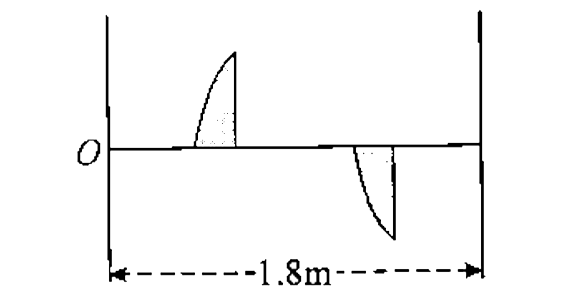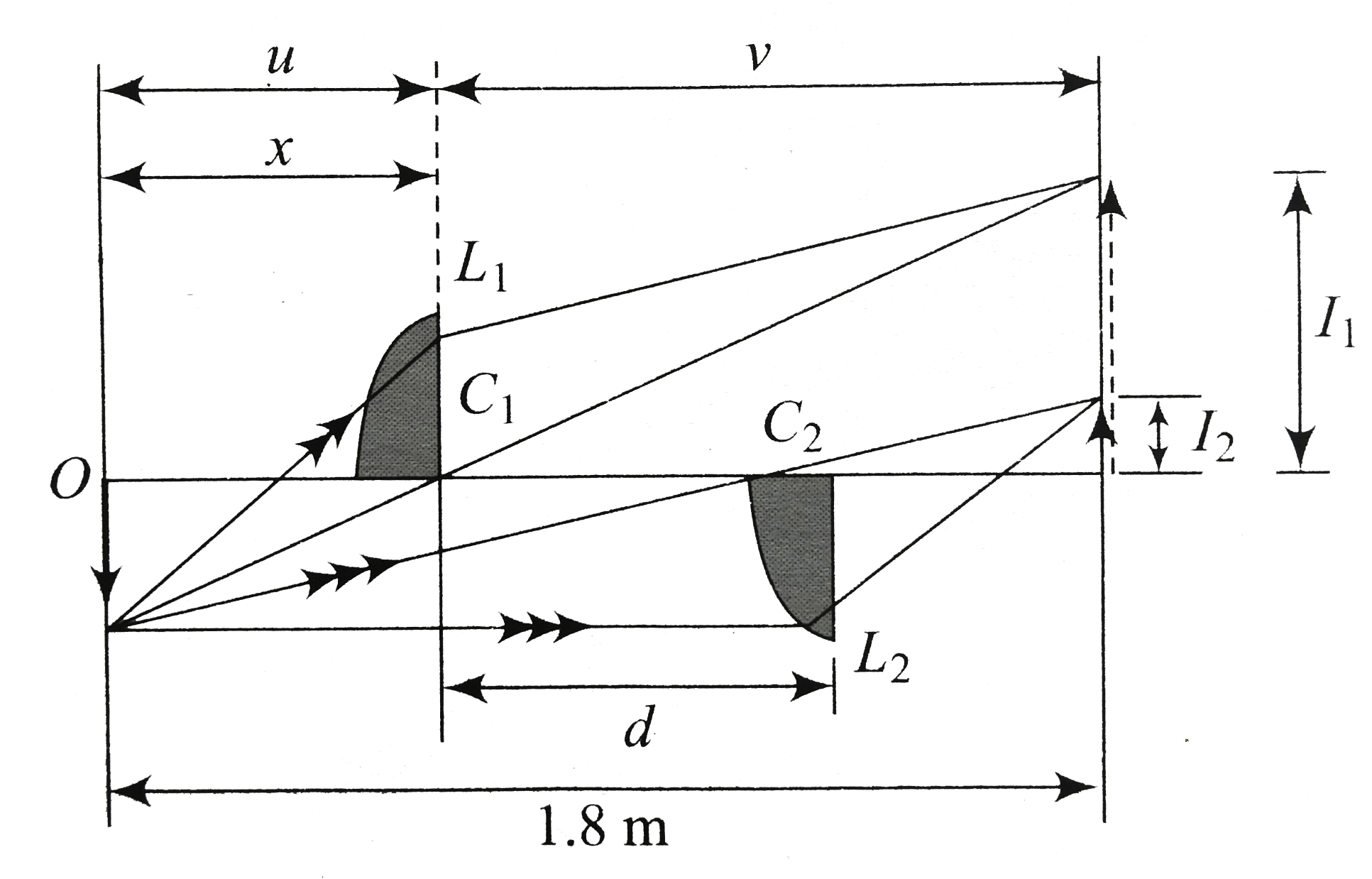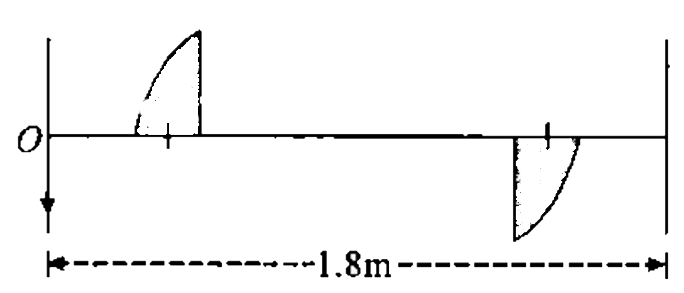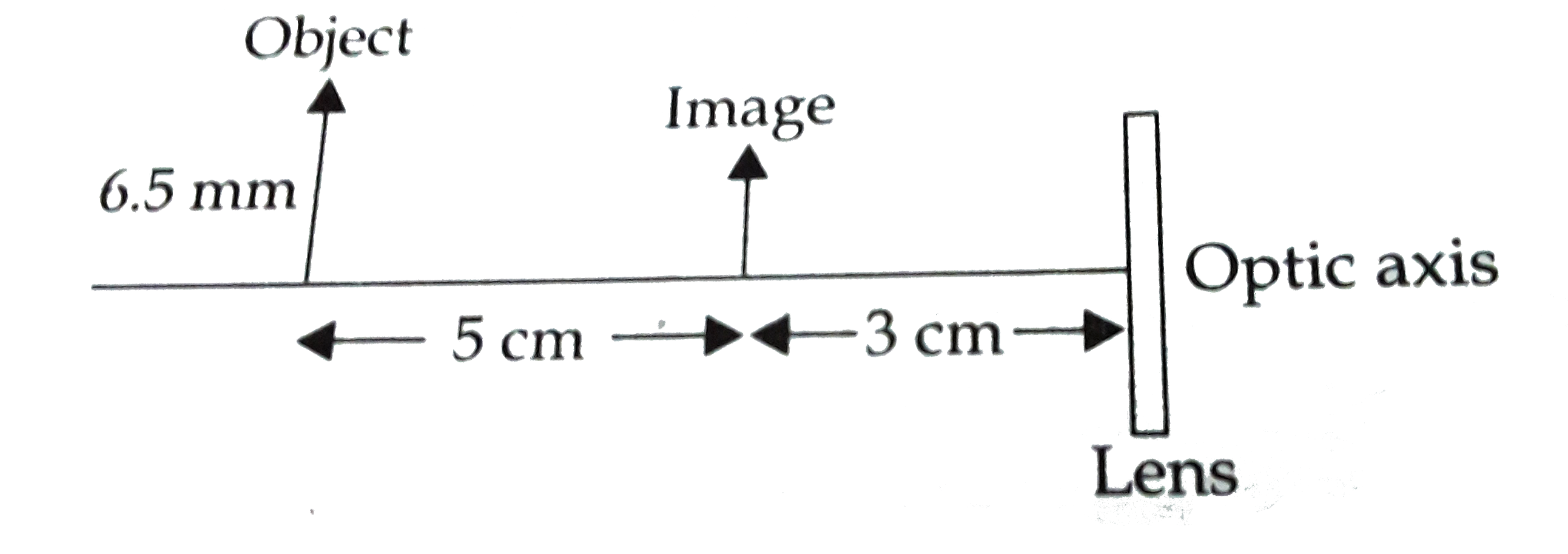A thin plano-convex lens of focal length f is split into two halves. One of the halves is shifted along the optical axis as shown in figure. The separation between object and image planes is 1.8 m. The magnification of the image, formed by one of the ball lens is 2. Find the focal length of the lens and separation between the two halves. Draw the ray diagram for image formation.

Let magnification caused by the first lens be 2 and distance OL1=x. Distance v of image from first lensL1 is given by
m=vu=2⇒v=2u=2x.
Clearly, u+v=1.8⇒x+2x=1.8m
or 3x=1.8m⇒x=1.83=0.6m
By sign convention,
u=−x=−0.6m,υ=2x=1.2m
Lens formula 1f=1v−1u gives
1f=11.2+10.6=1+21.2
∴ Focal length f=1.23=0.4m
For real image, lens formula takes the form
1f=1v+1u
Clearly, u and v are interchangeable. Therefore, for lens L2
u′=v=1.2m and v′=0.6m
OL1=L2I2=x
If d is the separation between the lenses, then
x+d+x=1.8m
∴d=1.8−2x=1.8−2×0.6=0.6m
Method-2 Since the magnification for L1 is 2
⇒vu=−2⇒D+d2−D−d2=−2
D+dD−d=2⇒D=1.8m,d=0.6m.
f=D2−d24D=(1.8+0.6)(1.8−0.6)4×1.8=0.4m

Topper's Solved these Questions
- BOOK - CENGAGE PHYSICSCHAPTER - GEOMETRICAL OPTICSEXERCISE - Exercise1.114videos
GEOMETRICAL OPTICS
- BOOK - CENGAGE PHYSICSCHAPTER - GEOMETRICAL OPTICSEXERCISE - Exercise1.220videos
GEOMETRICAL OPTICS
- BOOK - CENGAGE PHYSICSCHAPTER - GEOMETRICAL OPTICSEXERCISE - Integer Type4videos
GEOMETRICAL OPTICS
- BOOK - CENGAGE PHYSICSCHAPTER - FRICTIONEXERCISE - QUESTION BANK1videos
FRICTION
- BOOK - CENGAGE PHYSICSCHAPTER - GRAVITATIONEXERCISE - Question Bank39videos
GRAVITATION
Similar Questions
A thin plano-convex lens.of focal length f is split into two halves : One of the halves is shifted along the optical axis (figure)The separation between object and image planes is 1.8m.The magnification of the image formed by one of the half lensis 2. Find the focal length of the lens and separation between the two halves. Draw the ray diagram for image formation.
 View Solution
View SolutionA thin plano-convex lens of focal length f is split into two halves. One of the halves is shifted along the optical axis as shown in figure. The separation between object and image planes is 1.8 m. The magnification of the image, formed by one of the ball lens is 2. Find the focal length of the lens and separation between the two halves. Draw the ray diagram for image formation.
 View Solution
View Solution
Knowledge Check
- Question 1 - Select One
If a equiconvex lens of focal length f is cut into two halves by a plane perpendicular to the principal axis, then
AThe focal length of each half becomesf2BThe focal length of each half becomes 2fCThe focal length of each half remains fDThe focal length of each half becomes f4 - Question 2 - Select One
The distance between an object and its real image formed by a lens is D. If the magnification is m, the focal length of the lens is
A(m−1)DmBmD(m+1)C(m−1)Dm2DmD(m+1)2 - Question 3 - Select One
Shown an object and its image formed by a thin lens. Then the nature and focal length of lens is
 Af=4.8cm converging lensBf=−4.8cm diverging lensCf=2.18cm converging lensDf=−2.18cm diverging lens
Af=4.8cm converging lensBf=−4.8cm diverging lensCf=2.18cm converging lensDf=−2.18cm diverging lens
A thin plano-convex lens of focal length f is split into two halves. One of the halves is shifted along the optical axis as shown in figure. The separation between object and image planes is 1.8 m. The magnification of the image, formed by one of the ball lens is 2. Find the focal length of the lens and separation between the two halves. Draw the ray diagram for image formation.
 View Solution
View SolutionA thin double convex lens of focal length f is broken into two equal halves at the axis. The two halves are combined as shown in figure. What is the focal length of combination in (ii) and (iii).
 View Solution
View SolutionThe distance between the object and the real image formed by a convex lens is d. If the linear magnification is m, find the focal length of the lens in terms of d and m.
View SolutionDraw ray diagram showing the image formation by a convex lens when an object is placed at twice the focal length of the lens.
View SolutionA cocave lens forms the image of an object such that the distance between the object and image is 10 cm and the magnification produced is 1/4. the focal length of the lens will be
View Solution

